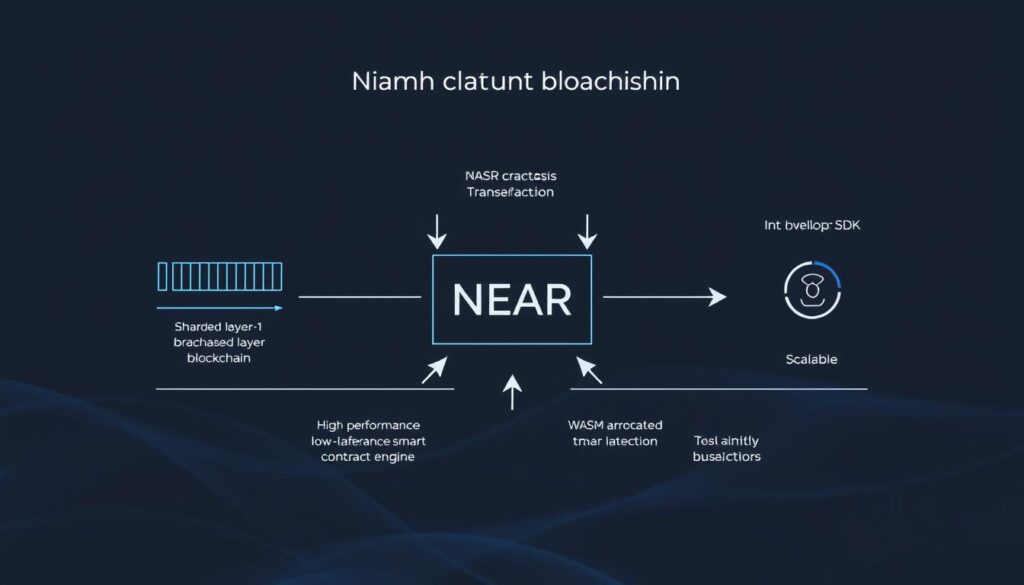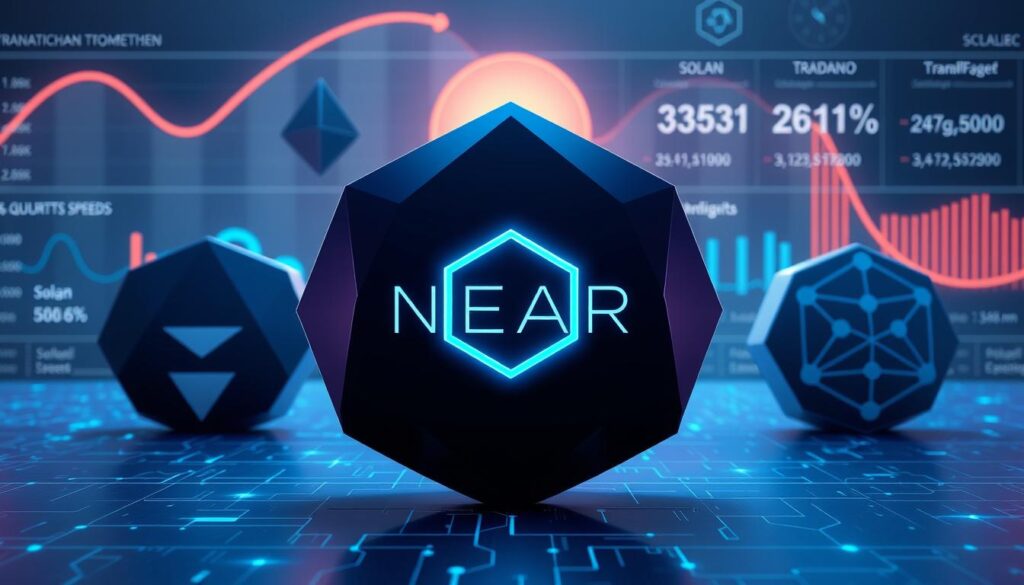Explore the Power of NEAR Protocol (NEAR)
Did you know over 80 million global merchants accept payments using NEAR Protocol’s tokens through the Crypto.com Visa Card? This shows how NEAR is making blockchain a part of our daily lives.
NEAR Protocol is a blockchain made for fast and secure smart contracts and apps. It uses Nightshade sharding to handle thousands of transactions per second. This way, it keeps everything safe and efficient.
NEAR also burns some transaction fees to reduce tokens, which helps it grow in the long run. It supports 20+ fiat currencies and works with Crypto.com, which offers 250+ cryptocurrencies. This makes it a bridge between traditional finance and blockchain.
The Rainbow Bridge lets users easily move Ethereum tokens to NEAR. Developers can use Rust and AssemblyScript to create new DeFi, NFT, and cross-chain apps.
Key Takeaways
- NEAR Protocol enables spending at 80+ million merchants via the Crypto.com Visa Card.
- Its Nightshade sharding boosts throughput while securing transactions at scale.
- Annual token supply growth stays at 5%, with 90% of new tokens rewarding validators.
- NEAR’s cross-chain features include Ethereum interoperability and gas payments using SWEAT or NEAR.
- Developers gain user-friendly tools and economic incentives for building scalable applications.
Understanding NEAR Protocol (NEAR)
NEAR Protocol is a decentralized blockchain platform. It aims to solve scalability and usability issues in crypto. Launched in 2020, it supports the NEAR cryptocurrency and has become a key hub for developers. Recent news shows its growth from a program synthesis project to a leading blockchain ecosystem.
What is NEAR Protocol?
NEAR Protocol is a layer-1 blockchain designed for scalable decentralized apps. Its Nightshade sharding technology can handle over 100,000 transactions per second. The NEAR cryptocurrency powers this network, with transactions costing just fractions of a cent and finalizing in seconds.
The History and Development of NEAR
- Founded in 2017 by Illia Polosukhin and Alexander Skidanov as NEAR.ai, initially focused on AI
- Launched mainnet April 2020, transitioned to community governance by September 2020
- Reached $530M in total funding by 2022, with a $2.4B market cap for NEAR cryptocurrency in July 2022
Core Philosophy Behind NEAR Protocol
NEAR’s mission is to make blockchain more accessible. It uses Delegated Proof of Stake (DPoS) for security and human-readable addresses for ease. The protocol aims to connect blockchains in a multi-chain future. It focuses on developer tools to encourage innovation in DeFi, NFTs, and gaming.
The Technical Foundation of NEAR Blockchain

The NEAR blockchain uses advanced NEAR technology for security and speed. It has a Proof-of-Stake (PoS) system. This means validators are picked based on how many tokens they hold, which saves energy.
This system gives validators 4.5% of all tokens each year. Also, 0.5% goes to the protocol treasury for updates.
- Sharding architecture splits tasks into parallel “chunks” to process 1000+ transactions per second.
- User-friendly account names like jane.near replace complex cryptographic addresses.
- Developer tools include Rust and AssemblyScript support, backed by Google Cloud integration.
| Feature | Description |
|---|---|
| Consensus | Proof-of-Stake (PoS) validation |
| Sharding | Nightshade protocol enabling parallel processing |
| Transaction Fees | Low costs due to efficient resource allocation |
| Token Supply | 5% annual inflation with 90% rewards for validators |
NEAR’s design lets it update easily without big changes. Over 1,000 projects use it, thanks to grants and help from developers. Soon, it will have features like easier transactions and mobile access, making it easier for everyone to use.
Nightshade Sharding: How NEAR Achieves Scalability
NEAR Protocol’s Nightshade architecture changes how blockchains scale. It uses sharding to split the network into smaller units. This lets many transactions happen at once without losing decentralization.
Unlike old systems, Nightshade keeps all shards in sync. This ensures the NEAR blockchain stays unified.
Breaking Down Nightshade Technology
- Divides network into independent shards for parallel transaction processing
- Stateless validation reduces node hardware requirements, encouraging broader participation
- Asynchronous execution allows real-time shard communication without performance bottlenecks
Throughput Capabilities and Performance Metrics
Phase 2 upgrades in May 2024 aim to boost performance with:
- Up to 100,000 transactions per second (TPS) capacity
- Sub-1 second average confirmation times
- Cost efficiency: 10x lower fees than Ethereum’s Layer 1
- 100% uptime in 2020 with no service interruptions
Comparison with Other Sharding Solutions
| Platform | TPS Range | Fee Structure | Decentralization |
|---|---|---|---|
| NEAR Protocol | 100k+ | Sub-penny transactions | Stateless nodes expand validator pool |
| Ethereum 2.0 | 100k+ (theoretical) | Gas fees fluctuate | Centralized validator requirements |
| Polkadot | 1,000 TPS | Per parachain fees | Substrate framework limitations |
| Zilliqa | Up to 2,400 TPS | Fixed per-transaction fees | Static shard count limits scaling |
NEAR is the first to fully use sharding at scale. This makes it great for global apps. It keeps speed and cost low for developers.
NEAR Token: Economics and Utility
The NEAR token is key to the NEAR cryptocurrency world. It’s used for staking, transaction fees, and making decisions. Validators get rewards for keeping the network safe. Users pay in NEAR for transactions and storage.
A special burn rule helps keep the token’s value up. It reduces the number of tokens over time. This fights against inflation.
Every epoch, some transaction fees are burned. This makes the total supply go down. This design helps keep the value of NEAR high over time.
The annual inflation is set at 5%. But, how much it actually is depends on how busy the network is. If there are lots of transactions, inflation can even go below zero. This means the supply can shrink even more.
| Storage Requirement | NEAR Tokens Needed | % of Total Supply |
|---|---|---|
| 10 KB | 1 Ⓝ | 0.0000001% |
| 10 MB | ~1,049 Ⓝ | 0.0001% |
| 100 MB | ~10,486 Ⓝ | 0.00107% |
| 1 TB | ~109,951,163 Ⓝ | 11.00% |
Staking rewards give investors 10-11% APY each year. This attracts people looking for passive income. Validators get 90% of the 5% annual increase, with 0.5% for ecosystem growth. This balance keeps the network safe and rewarding.
Transaction fees help run the network, with 30% going to contracts. Gas prices change with network load. This keeps costs low. The economic plan focuses on growing and staying strong, benefiting everyone involved.
The Growing NEAR Ecosystem
The NEAR ecosystem is a hub for new ideas, supporting over 1,000 projects and 30.5 million users. It powers DeFi platforms and social media, showing its wide range of uses for Web3 apps.
- DeFi Leadership: Ref Finance and Burrow thrive on NEAR’s low fees and high transaction speed. TVL saw a 34% increase in late 2023, showing its growing popularity.
- NFT Innovation: NEAR helps creators and collectors launch NFTs and digital items. KAIKAI.ai combines social media with blockchain rewards, drawing in new users.
- Gaming Breakthroughs: Games like Sweat Economy reward players with crypto for physical activity. Metaverse projects use NEAR for fast, smooth virtual experiences.
- Developer Support: NEAR Horizon supports over 165 projects with funding and tools. Developers use Rust and AssemblyScript to build apps, with 5,600 contributors pushing the limits of innovation.
Recent achievements include a 42% rise in daily transactions and 30.8% more new users than in August 2023. NEAR aims to welcome 1 billion users by making blockchain easier to use. This growth makes NEAR projects leaders in bringing decentralized tech to the masses.
Aurora: Ethereum Compatibility Layer on NEAR

Aurora connects Ethereum’s world to the NEAR Protocol. It lets developers easily move dApps to NEAR. This makes NEAR a better choice for Ethereum projects, keeping EVM standards intact.
- ERC-20 transfers cost under $0.01 vs. Ethereum’s $5.40
- Transaction finality in 2 seconds—5x faster than Ethereum’s 13-second average
- 1,000x cheaper fees than Ethereum’s Layer 1 network
The Rainbow Bridge makes it safe to move assets between NEAR and Ethereum. It uses NEAR’s tech to check cross-chain deals without needing a third party. This means users can move assets like ETH or USDT quickly.
Aurora grows by using NEAR’s sharding tech. It supports thousands of transactions per second. Developers can write smart contracts in Solidity, paying fees in ETH or NEAR. This has drawn DeFi platforms and NFT projects to Aurora, growing the NEAR projects ecosystem.
In late 2021, Aurora had a token sale. It offered 300,000 $AURORA tokens at $1 each. People used NEAR or HAPI tokens, with HAPI adding security. Now, the Aurora DAO lets token holders vote on updates, driving innovation.
Aurora combines NEAR’s speed with Ethereum’s compatibility. It opens new doors for developers who want to scale without losing interoperability. This makes NEAR projects leaders in cross-chain innovation.
NEAR Price Analysis and Market Position
NEAR Protocol’s NEAR token is in a tough market. It balances new ideas with ups and downs. The current price shows its aim for growth and the challenges it faces.
Historical Price Movements
NEAR’s price hit $20.42 in 2021 but now is at $3.05. It fell 9.79% in a week but rose 4.16% in a day. Key levels are $3.10-$3.28 and $2.75-$2.93.
Market Capitalization and Liquidity
NEAR’s market cap is $7.9 billion, placing it in the middle. It has a 8.69% volatility and 17 green days in 30. This shows moderate liquidity. It’s also closely tied to the top 100 coins, but diversification is limited.
| Year | Min Price | Avg Price | Max Price | Potential ROI |
|---|---|---|---|---|
| 2025 | $2.85 | $3.15 | $3.37 | 10.56% |
| 2026 | $5.77 | $5.93 | $6.97 | 95.28% |
| 2027 | $8.15 | $8.45 | $9.89 | 7.37% |
| 2028 | $11.82 | $12.16 | $14.10 | 18.66% |
| 2029 | $17.18 | $17.67 | $20.37 | 145.04% |
| 2030 | $26.32 | $27.21 | $30.11 | 215.06% |
Investment Perspective and Future Outlook
Experts think NEAR could reach $27.21 by 2030. This is thanks to new tech and efficiency. But, there are risks like fewer users and Ethereum’s strong position. The near future has hurdles at $3.10-$3.28.
- 2025 possible ROI: 10.56%
- 2026 ROI: 95.28%
- 2030 ROI: 215.06%
NEAR Protocol’s NEAR token faces competition from Ethereum but wins with lower fees. Technical analysis shows a bearish trend. Yet, long-term, it could see a 215% ROI by 2030 if more people use it. Interest from big investors and tools for developers might help with the ups and downs.
NEAR Protocol vs. Competing Layer-1 Blockchains

NEAR Protocol goes up against Ethereum, Solana, and Avalanche in the smart contract world. Its NEAR blockchain uses sharding and Proof-of-Stake (PoS) for quicker, cheaper transactions. It beats Ethereum in speed, achieving finality in just 1 second.
NEAR also shines in energy use. It produces 174 tons of CO2 annually, which is 200,000 times less than Bitcoin.
- Speed & Cost: NEAR can handle up to 100,000 transactions per second (TPS), though it currently runs 5-20 TPS. Ethereum’s average fee is $15; NEAR transactions cost cents.
- Decentralization: NEAR’s Nakamoto Coefficient is lower than Solana and Avalanche, indicating stronger resistance to validator collusion.
- Developer Ecosystem: Over 300 apps run on NEAR, with a $350M grant fund fueling growth. Its developer tools outpace all but Solana’s.
- User Experience: Human-readable account names simplify participation compared to complex addresses systems on Ethereum or Binance Smart Chain.
NEAR’s Nightshade sharding is different from Ethereum’s layer-2 rollups and Solana’s single-chain approach. It has a 5% annual token emission and 11.7% APY for stakers, attracting users. Yet, its younger ecosystem means less adoption than Ethereum.
Despite this, partnerships like the Aurora bridge—handling $750M in TVL—show promise. As NEAR expands sharding capacity, its NEAR blockchain aims to balance scalability and usability without sacrificing security.
Conclusion: The Future of NEAR Protocol in the Blockchain Landscape
NEAR Protocol is leading in blockchain innovation with its scalable design and user-friendly features. In 2022, it received funding that helped improve its ecosystem. This includes Nightshade sharding, which handles thousands of transactions per second.
NEAR is also focusing on AI, using an energy-efficient model that’s carbon-neutral. This model is much less energy-intensive than Bitcoin. It supports global sustainability goals.
NEAR keeps up with Ethereum through cross-chain bridges like Aurora and the Rainbow Bridge. Its DeFi and NFT sectors are growing fast, with TVL up 300% in a year. As it scales to 10 shards, it will handle more transactions, beating rivals like Ethereum and Solana.
Market data shows NEAR’s growth: it could hit $47 by 2030, with some predictions over $2,100 by 2040. Despite competition and regulatory issues, NEAR is attracting projects with its cost-effective solutions. Its carbon-neutral model and growing ecosystem aim to balance innovation with practical challenges, shaping the future of decentralized tech.




